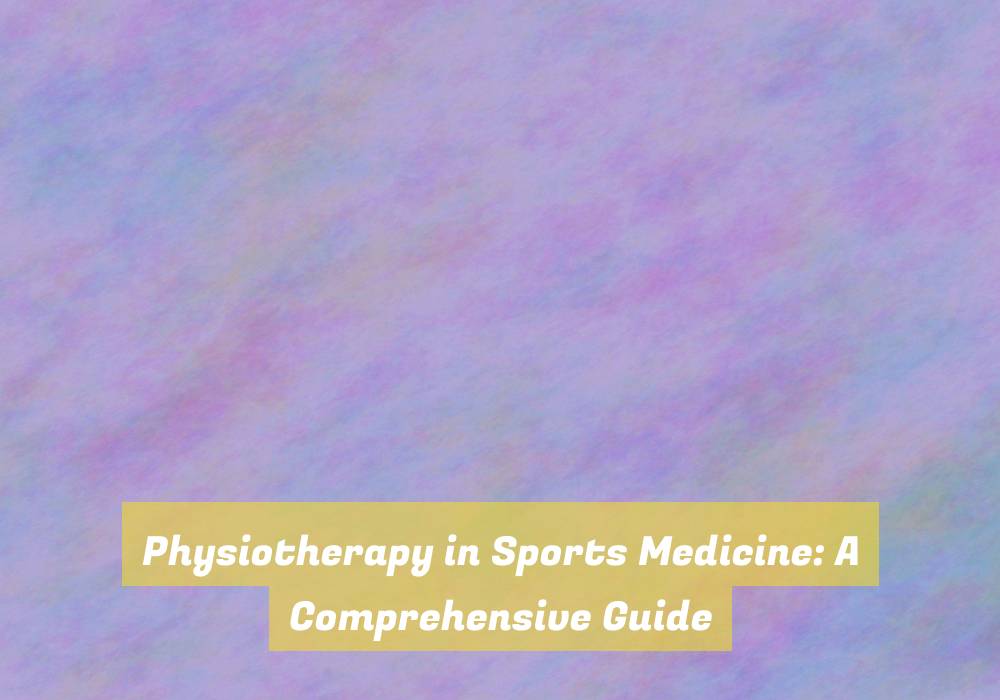Physiotherapy in Sports Medicine: A Comprehensive Guide
Welcome to the world of physiotherapy in sports medicine, where precision and performance go hand in hand. From preventing injuries to enhancing athletic abilities, the role of physiotherapy in sports medicine is paramount.
But what exactly does it entail, and how can it benefit both professional athletes and weekend warriors alike? Whether youG??re a coach, athlete, or simply someone with an interest in sports medicine, this comprehensive guide will equip you with the knowledge and tools to understand and implement physiotherapy techniques effectively.
So, letG??s explore the intricacies of physiotherapy in sports medicine and uncover the secrets to optimizing athletic performance and recovery.
Role of Physiotherapy in Sports Medicine
In sports medicine, physiotherapy plays a crucial role in rehabilitating and preventing injuries for athletes of all levels. Physiotherapists are highly skilled in assessing and treating musculoskeletal injuries, making them instrumental in the recovery process. They work closely with athletes to design personalized rehabilitation programs that aim to restore function, alleviate pain, and prevent further injury.
Through a combination of manual therapy, therapeutic exercises, and modalities such as ultrasound and electrical stimulation, physiotherapists help athletes regain strength, flexibility, and mobility.
Moreover, physiotherapy contributes significantly to injury prevention. By identifying and addressing biomechanical imbalances or weaknesses, physiotherapists can help athletes improve their movement patterns and reduce the risk of future injuries. They also provide education on proper warm-up and cool-down techniques, as well as guidance on effective stretching and strengthening exercises.
In essence, physiotherapy in sports medicine isnG??t only about treating injuries but also about empowering athletes to take control of their physical well-being. Whether itG??s recovering from a specific injury or proactively working to prevent future ones, the role of physiotherapy is indispensable in keeping athletes performing at their best.
Common Sports Injuries and Rehabilitation
Recovering from common sports injuries often requires a tailored rehabilitation program designed to address specific physical challenges and promote optimal healing and recovery.
One of the most prevalent sports injuries is the sprained ankle, which necessitates a comprehensive rehabilitation plan involving exercises to improve strength, flexibility, and balance.
Additionally, physiotherapy plays a crucial role in the recovery from knee injuries such as anterior cruciate ligament (ACL) tears, utilizing a combination of manual therapy and therapeutic exercises to restore function and stability.
Shoulder injuries, including rotator cuff tears, often require targeted rehabilitation to enhance mobility and strength while minimizing the risk of re-injury.
For hamstring strains, a structured rehabilitation program focuses on progressive exercises to regain flexibility and strength in the injured muscle.
ItG??s essential to understand that each injury demands a customized rehabilitation approach to address specific needs and facilitate a safe return to sports. By working closely with a physiotherapist, you can ensure that your rehabilitation program effectively targets the unique requirements of your injury, promoting a successful recovery and a swift return to your athletic pursuits.
Techniques and Exercises in Physiotherapy
Utilize a variety of specialized techniques and targeted exercises to promote healing and improve physical function in physiotherapy for sports medicine.
Manual therapy, such as joint mobilization and soft tissue mobilization, helps restore joint mobility, reduce pain, and enhance tissue flexibility.
Therapeutic exercises tailored to specific sports-related injuries aim to rebuild strength, flexibility, and endurance. For instance, eccentric exercises can aid in tendon healing, while proprioception and balance exercises are crucial for ankle sprains.
Additionally, neuromuscular retraining focuses on improving coordination and movement patterns to prevent re-injury.
Modalities like ultrasound and electrical stimulation assist in pain management and tissue repair.
Furthermore, functional training simulates sport-specific movements to prepare athletes for a safe return to play. Plyometric exercises enhance power and agility, whereas agility drills improve coordination and speed.
ItG??s essential to individualize treatment plans, considering the athleteG??s sport, position, and unique physical demands.
Incorporating these techniques and exercises into physiotherapy fosters optimal recovery and empowers athletes to perform at their best.
Integrating Physiotherapy Into Training Programs
Integrating physiotherapy into training programs involves customizing exercises and techniques to enhance athletesG?? performance and prevent re-injury, building upon the targeted approach used in sports medicine physiotherapy. By incorporating physiotherapy into training, you can address specific weaknesses or imbalances in athletes, helping them improve overall strength, flexibility, and mobility. This tailored approach not only optimizes performance but also reduces the risk of future injuries.
Furthermore, integrating physiotherapy into training programs allows for a seamless transition from rehabilitation to performance enhancement. Physiotherapists work closely with coaches and trainers to develop individualized programs that complement the athletesG?? training routines. This collaboration ensures that the exercises and techniques align with the overall training goals while addressing any lingering physical issues.
Moreover, by integrating physiotherapy into training, athletes can benefit from ongoing monitoring and adjustments to their programs. This proactive approach helps identify and address potential issues before they escalate, ultimately contributing to sustained peak performance and reduced time off due to injuries.
Conclusion
So, now you have a comprehensive understanding of the role of physiotherapy in sports medicine.
YouG??ve learned about common sports injuries and the rehabilitation techniques and exercises used in physiotherapy.
You also know how to integrate physiotherapy into training programs.
With this knowledge, youG??re well-equipped to support athletes in their journey to recovery and improved performance.
Keep up the great work in helping athletes reach their full potential!







Your exploration of the role of physiotherapy in sports medicine brings an important topic to the foreground, particularly as we see a growing recognition of the need for injury prevention and rehabilitation tailored to athletes of all levels. As someone who has both observed and benefited from physiotherapy in my athletic pursuits over the years, I can attest to the profound impact these practices have on not only recovery but also on optimizing performance.